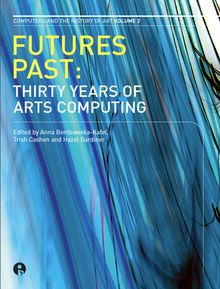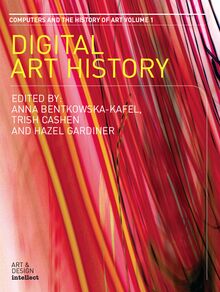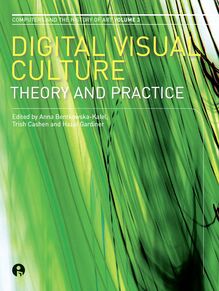-
 Univers
Univers
-
 Ebooks
Ebooks
-
 Livres audio
Livres audio
-
 Presse
Presse
-
 Podcasts
Podcasts
-
 BD
BD
-
 Documents
Documents
-
- Cours
- Révisions
- Ressources pédagogiques
- Sciences de l’éducation
- Manuels scolaires
- Langues
- Travaux de classe
- Annales de BEP
- Etudes supérieures
- Maternelle et primaire
- Fiches de lecture
- Orientation scolaire
- Méthodologie
- Corrigés de devoir
- Annales d’examens et concours
- Annales du bac
- Annales du brevet
- Rapports de stage
La lecture à portée de main
Vous pourrez modifier la taille du texte de cet ouvrage
Découvre YouScribe en t'inscrivant gratuitement
Je m'inscrisDigital Art History , livre ebook
Découvre YouScribe en t'inscrivant gratuitement
Je m'inscrisEn savoir plus
Vous pourrez modifier la taille du texte de cet ouvrage
En savoir plus

Description
Sujets
Informations
| Publié par | Intellect Books |
| Date de parution | 01 janvier 2005 |
| Nombre de lectures | 0 |
| EAN13 | 9781841509105 |
| Langue | English |
Informations légales : prix de location à la page 0,1600€. Cette information est donnée uniquement à titre indicatif conformément à la législation en vigueur.
Extrait
Digital Art History
A Subject in Transition
Computers and the History of Art Volume One
Edited by
Anna Bentkowska-Kafel, Trish Cashen and Hazel Gardiner
First Published in the UK in 2005 by
Intellect Books, PO Box 862, Bristol BS99 1DE, UK
First Published in the USA in 2005 by
Intellect Books, ISBS, 920 NE 58th Ave. Suite 300, Portland, Oregon 97213-3786, USA
Copyright 2005 Intellect Ltd
All rights reserved. No part of this publication may be reproduced, stored in a retrieval system, or transmitted, in any form or by any means, electronic, mechanical, photocopying, recording, or otherwise, without written permission.
A catalogue record for this book is available from the British Library.
Electronic ISBN 1-84150-910-8 / ISBN 1-84150-116-6
ISSN 1743-3959
Cover Design: Gabriel Solomons
Copy Editor: Julie Strudwick
Printed and bound in Great Britain by Antony Rowe Ltd.
Digital Art History
A Subject in Transition
Exploring Practice in a Network Society
Computers and the History of Art, Yearbook 2004, Volume 1
Edited by Anna Bentkowska-Kafel, Trish Cashen and Hazel Gardiner
This edition is drawn from papers presented at the CHArt annual conferences held at the British Academy, 27-28 November 2001 and 14-15 November 2002 respectively. The CHArt Committee refereed the conferences and papers. With the exception of William Vaughan s article, the papers are also available online at www.chart.ac.uk. William Vaughan s article is an expanded and revised version of a text published in the proceedings of the EVA Conference Electronic Imaging and the Visual Arts , 25 July 2002, Imperial College, London, pp. 1.1-5. It is also available online in zeitenblicke 2 (2003), Nr. 1 [8 May 2003], www.zeitenblicke.historicum.net/2003/01/vaughan/index.html .
Disclaimer: The articles in this collection express the views of the authors and not necessarily those of the members of the CHArt Committee.
Articles individual author(s) and reproduction is with their permission.
Illustrations individual authors.
All rights reserved. No part of this publication may be reproduced, stored in a retrieval system or transmitted in any form or by any means, electrical, mechanical or otherwise, without first seeking the written permission of the copyright owners and of the publisher.
CHArt Editor in Chief: Charlie Gere
CHArt Managing Editor: John Sunderland
CHArt Committee:
Christopher Bailey, Northumbria University, UK
Anna Bentkowska-Kafel, Courtauld Institute of Art, London, UK
Trish Cashen, The Open University, UK
Marilyn Deegan, Oxford University, UK
Rupert Faulkner, Victoria and Albert Museum, UK
Hazel Gardiner, Birkbeck College, London, UK
Charlie Gere (Chair), Birkbeck College, London, UK
Marlene Gordon, University of Michigan, USA
Michael Hammel, IT University, Copenhagen, Denmark
Colum Hourihane, Princeton University, USA
Hubertus Kohle, Ludwig Maximilians University, Munich, Germany
Dunja Kukovec, Ljubljana, Slovenia
Phillip Purdy, Museums, Libraries and Archives Council, London, UK
John Sunderland, London, UK
Tanya Szrajber, British Museum, London, UK
William Vaughan, Birkbeck College, London, UK
Suzette Worden, Curtin University of Technology, Perth, Australia
CHArt, School of History of Art, Film and Visual Media, Birkbeck College, University of London, 43 Gordon Square, London WC1H 0PD. Te l: +44 (0)20 7631 6181, Fax: +44 (0)20 7631 6107, www.chart.ac.uk, Email: publications@chart.ac.uk .
Table of Contents
Contributors
Introduction by William Vaughan
TEACHING AND COMMUNICATION
History of Art in the Digital Age: Problems and Possibilities by William Vaughan
Animating Art History: Digital Ways of Studying Colour in Abstract Art by Mary Pearce
VISUALISING THE PAST
The Cathedral as a Virtual Encyclopaedia: Reconstructing the Texts of Chartres Cathedral by Stephen Clancy
With Camera to India, Iran and Afghanistan: Access to Multimedia Sources of the Explorer Professor Dr Morgenstierne (1892-1975) by Wlodek Witek
ONLINE ART
Towards a Yet Newer Laocoon. Or, What We Can Learn from Interacting with Computer Games by Michael Hammel
Digital Arts On (the) Line by Dew Harrison and Suzette Worden
METHODS AND PRACTICES
Bringing Pictorial Space to Life: Computer Techniques for the Analysis of Paintings by Antonio Criminisi, Martin Kemp and Andrew Zisserman
Enhancing a Historical Digital Art Collection: Evaluation of Content-Based Image Retrieval on Collage by Annette A. Ward, Margaret E. Graham, K. Jonathan Riley and Nic Sheen
Abstracts
CHArt - Computers and the History of Art
Guidelines for Submitting Papers for the CHArt Yearbook
Contributors
Anna Bentkowska-Kafel is currently working on digitisation of images for the Corpus of Romanesque Sculpture in Britain and Ireland ( www.crsbi.ac.uk ) and is Researcher for the Digital Image Archive Group at Birkbeck College, London. Her research, teaching and publications have been mainly on early modern visual culture in Western Europe, with special interest in cosmological and anthropomorphic representations of nature; as well as the use of digital imaging in iconographical analysis and interpretation of paintings. She has an M.A. in the History of Art (Warsaw), M.A. in Computing Applications for the History of Art (London) and Ph.D. in Digital Media Studies (Southampton). She has been a member of the CHArt committee since 1999.
Trish Cashen has been involved with integrating computing into university level humanities teaching since 1993. Initially Research Officer for Art History with the CTI (Computers in Teaching Initiative), she moved to Birkbeck College where she taught on the M.A. in Computer Applications for the History of Art, and The Open University, where she is currently charged with exploiting new media for teaching arts subjects. Her main areas of interest are exploring the pedagogical effectiveness of new media and using the Internet for art history - she maintains the WWW Virtual Library for the History of Art ( www.chart.ac.uk/vlib/ ). At present she is working on the educational potential of DVD video, as well as contributing to an interactive CD-ROM of the Soane Museum and to electronic resources for the Open University s M.A. in Art History. She has been a member of the CHArt committee since 1994.
Stephen Clancy has a Ph.D. in Art History from Cornell University. Since 1988 he has been a professor in the Department of Art History at Ithaca College in New York, where he currently serves as Chair. He teaches medieval art and architecture and Northern Renaissance painting and sculpture, as well as courses on visual persuasion and the rhetoric of art. He has also published on the fifteenth-century French manuscript illuminator and panel painter Jean Fouquet. He spent a year in Belgium on a Fulbright research scholarship studying the manuscript illumination of Simon Marmion.
Antonio Criminisi has a Ph.D. in Computer Vision from the University of Oxford. His thesis Accurate Visual Metrology from Single and Multiple Uncalibrated Images won the British Computer Society Dissertation Award for the year 2000 and was published by Springer-Verlag London Ltd. in 2001. His research interests are in the area of image-based modelling, texture analysis, video analysis and editing, 3D reconstruction from single and multiple images with application to Virtual Reality, Forensic Science, Image-Based Rendering and Art History.
Hazel Gardiner is Research Officer for the M.A. Digital Art History (formerly M.A. Computer Applications for the History of Art) at Birkbeck College, and Visiting Research Fellow at the Centre for Computing in the Humanities at Kings College, London. Until mid-2003 she was the Research Assistant for the Corpus of Romanesque Sculpture in Britain and Ireland, ( www.crsbi.ac.uk) , and continues to work as a voluntary fieldworker for the project. She is currently studying for a Ph.D. in twelfth-century British sculpture. She has been a member of the CHArt committee since 1997.
Margaret Graham is Director of Research, Business Information Systems, in the School of Informatics, Northumbria University, UK. Previously, Margaret was Research and Development Manager at the Institute for Image Data Research, which is now part of the School. Her research interests include image users, image seeking behaviour, and image data management. She has published in library, computing and art history areas and has presented papers on her research in IIDR at a number of international conferences.
Michael Hammel is an independent art historian working freelance as a designer and researcher in interactive media. He read Art History, Mathematics and Media at the University of Aarhus, Denmark, and Media Science at the University of Copenhagen, Denmark. He is currently working on his Ph.D. on interactive art. He has been a member of the CHArt committee since 2001.
Dew Harrison is a research fellow at Gray s School of Art for the Robert Gordon University in Aberdeen, where her research concerns digital and computer- mediated art work. Her own practice concerns non-linear narrative and the semantic association of thought and idea in multimedia form. She also works as a Director of PVA.Org s LabCulture Ltd. Prior to this she has lectured in interactive art, multimedia and new media theory and was the research fellow for the Arts and Humanities Research Board funded project Digital Art Curation & Practice: Aesthetics, Participation & Diversity, based at the University of the West of England. In this capacity she curated the international online exhibition Net_Working with the Watershed Media Centre, Bristol and created and produced the DARN website (Digital Art Resource Network) set up to facilitate the practice, production and showcasing of art work in new media.
Martin Kemp is Professor of History of Art at the University of Oxford, UK. His primary research interest is in the relationship between scientific models of natur
-
 Univers
Univers
-
 Ebooks
Ebooks
-
 Livres audio
Livres audio
-
 Presse
Presse
-
 Podcasts
Podcasts
-
 BD
BD
-
 Documents
Documents
-
Jeunesse
-
Littérature
-
Ressources professionnelles
-
Santé et bien-être
-
Savoirs
-
Education
-
Loisirs et hobbies
-
Art, musique et cinéma
-
Actualité et débat de société
-
Jeunesse
-
Littérature
-
Ressources professionnelles
-
Santé et bien-être
-
Savoirs
-
Education
-
Loisirs et hobbies
-
Art, musique et cinéma
-
Actualité et débat de société
-
Actualités
-
Lifestyle
-
Presse jeunesse
-
Presse professionnelle
-
Pratique
-
Presse sportive
-
Presse internationale
-
Culture & Médias
-
Action et Aventures
-
Science-fiction et Fantasy
-
Société
-
Jeunesse
-
Littérature
-
Ressources professionnelles
-
Santé et bien-être
-
Savoirs
-
Education
-
Loisirs et hobbies
-
Art, musique et cinéma
-
Actualité et débat de société
- Cours
- Révisions
- Ressources pédagogiques
- Sciences de l’éducation
- Manuels scolaires
- Langues
- Travaux de classe
- Annales de BEP
- Etudes supérieures
- Maternelle et primaire
- Fiches de lecture
- Orientation scolaire
- Méthodologie
- Corrigés de devoir
- Annales d’examens et concours
- Annales du bac
- Annales du brevet
- Rapports de stage








